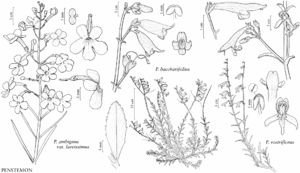Penstemon rostriflorus
Hutchings’ Ill. Calif. Mag. 5: 102, fig. [p. 102]. 1860. (as Pentstemon rostriflorum)
Stems (24–)30–100 cm. Leaves: basal and proximal cauline 20–52 × 3–11 mm, blade base tapered, margins entire, apex obtuse; cauline 4–12 pairs, 20–70 × 2–14 mm, blade base tapered, apex obtuse or acute. Thyrses (3–)6–28 cm, verticillasters (3–)6–12, cymes 2–5-flowered; proximal bracts lanceolate to linear, 6–36 × 1–6 mm; peduncles and pedicels glandular-pubescent. Flowers: calyx lobes ovate to lanceolate, 4–6 × 1.7–2.1 mm; corolla orangish red to scarlet, throat usually yellowish or orangish, unlined internally, 22–33 mm, sparsely white-puberulent, tube 3–5 mm, throat 4–6 mm diam.; pollen sacs 1.8–2.3(–2.5) mm; staminode 14–16 mm; style 18–26 mm, exserted. Capsules 7–10 × 4–5 mm. 2n = 16.
Phenology: Flowering Jul–Aug(–Sep).
Habitat: Rocky sagebrush shrublands, pinyon-juniper woodlands, montane forests.
Elevation: 1200–3200 m.
Distribution
Ariz., Calif., Colo., Nev., N.Mex., Utah, Mexico (Baja California).
Discussion
A chromosome count of 2n = 42 (P. G. Zhukova 1967) appears to be in error.
The Kawaiisu tribe of southern California prepared a poultice from the roots of Penstemon rostriflorus that was applied to swollen limbs (D. E. Moerman 1998).
Selected References
None.
